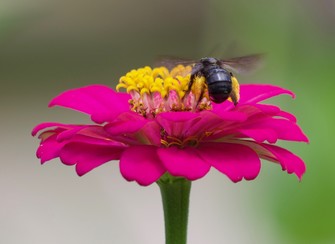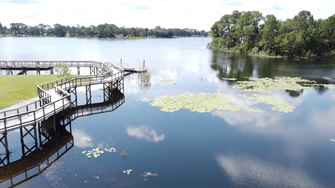 Photo by Travis Blunden, FWC
We often think of nature as something that we need to travel to access. When we imagine an authentic natural experience, we might picture a backpacking trip on the Florida Trail, a weekend of camping deep in the woods or a long kayak trip down one of our scenic rivers. While these wild spaces are an important part of Florida’s landscape, their distance from us means that we don’t get to experience this kind of nature every day. Luckily, simply changing the way we think about our definition of nature can help us form deeper connections with the natural world. Right outside your door there is a whole world to explore. There are caterpillars metamorphosizing into beautiful butterflies, birds building their nests and raising their young, and bees buzzing on beautiful flowers.
Exploring nature in your backyard is an excellent way for both children and adults to get some fresh air and to burn off pent-up energy. And, as an added bonus, at the height of Florida summer you won’t be too far from the respite of your home’s air conditioning! Even if you’re not an expert, you can identify plants and animals using apps like iNaturalist and Seek (the latter geared toward younger children); just by uploading a picture you can get an identification on the spot. If you’re interested in learning about the birds you see, try the Merlin ID app. Just three simple questions will help you identify any birds in North America. Once you’ve identified them, you can learn more about each species from Cornell’s All About Birds website.
Set aside some time for nature. Enjoy some sunshine in your backyard. Listen to the birds outside your window. Take a deep breath and give yourself a moment to appreciate the natural world around you.
 White-winged doves congregate at a backyard feeder. Photo by Kelly O'Connor.
Backyard birding can be a gateway into nature – Kelly O’Connor shared this story of the feathered friends in her yard and how she is transforming her outdoor space into an oasis for wildlife!
“When my husband and I moved into our current home in the summer of 2017 we were not avid birders. Some time after that we realized our neighborhood was home to a flock of White-winged Doves, a new species for both of us. We started counting them when they visited our yard and made a house checklist on eBird. After that we started spending more and more of our free time birding. In 2018 we had a total of 61 species on the house checklist. In 2019 that count rose to 92, with some extra special sightings including a Purple Finch, 16 species of warblers, and a Summer Tanager that overwintered with us. 2019 also marked the year we started to make our little yard a little more wildlife friendly. We planted coral honeysuckle and firebush around the yard as natural hummingbird feeders. We built a brush pile for cover that was quickly occupied by a family of Carolina Wrens, and added a DIY water feature that all the birds use regularly. Just this month (March 2020) we’ve seen 60 species in (and flying over) the yard. I’m working from home as much as possible, and with that comes more time in the morning and afternoon to sit out in the yard with binoculars and birdwatch. House bird #103 was a Louisiana Waterthrush that I spotted walking through the backyard while I was answering emails (the home office has a great view of our feeders).”
Have a backyard birding story you’d like to share? Email us at wildlifeviewing@myfwc.com for a chance to be featured in Kite Tales!
 The Lake McGarity Wildlife Viewing Station at Campbell Park includes a two-story observation tower for excellent views of waterbirds. Photo courtesy City of Deltona.
The city of Deltona started as a master planned retirement community developed by the General Development Corporation. The vision was a familiar one to Florida - provide affordable single-family homes to retirees. Deltona opened in 1962 and has since grown to be the largest city in Volusia County in population and physical size. Although the street parcel layout may appear to be stereotypical “suburban,” there is a lot more to the Deltona story than what the street map tells you. Deltona is on its way to becoming a nature park showcase.
 Trails at Thornby Park wind through 40 acres of pristine wooded property. Photo courtesy City of Deltona.
You see, when the city was being planned, a substantial amount of acreage was left undeveloped. In some cases, 50+ acre swaths of land were leapfrogged over and today remain in their natural state. The city of Deltona recognized that these land holdings represented a sustainable treasure for both residents and visitors. The city’s EcoParks Program was born in 2010.
Today seven EcoParks are open to the public and they allow passive access to habitats that range from hardwood swamp to sand hill scrub, pine prairie and hundreds of acres of lakes. The EcoParks program is growing, with an additional six parks being considered for public use. The Deltona nature idea is a simple concept – make nature accessible to all residents to enhance the quality of life. For instance, although Deltona is driving distance to the world class Merritt Island National Wildlife Refuge, the local Audubon EcoPark will enable residents to enjoy a birding hotspot within the city limits. More than 200 bird species sightings have been made in the Audubon EcoPark.
 An oak tree shades a waterside picnic spot at Audubon EcoPark. Photo courtesy City of Deltona.
Longer term, the city intends to become an Eco-Tourism hub, given its central location on the Florida Coast-to-Coast Trail. As a designated Trail Town, Deltona plans to link up its EcoParks with pathways. While there, an Eco-Tourist will have the ability to visit EcoParks via bicycle or by paddling a planned Blueway Trail that will traverse the city’s Butler Chain of Lakes.
Once regarded as a large suburban retirement community, Deltona is a great example of taking advantage of natural assets. As such, the City hired Jerry Mayes as the city’s Ecological Tourism Manager and he sums it up with this quote: “We want our residents and visitors to realize nature is closer than they may think. Although we are thrilled that conservation of these lands is a sustainable practice, the most important part of this unique program is to enhance quality of life – because access to natural places make a happy and healthy community.”
For more information about the City of Deltona’s EcoParks, please visit www.FloridaEcoParks.com
|